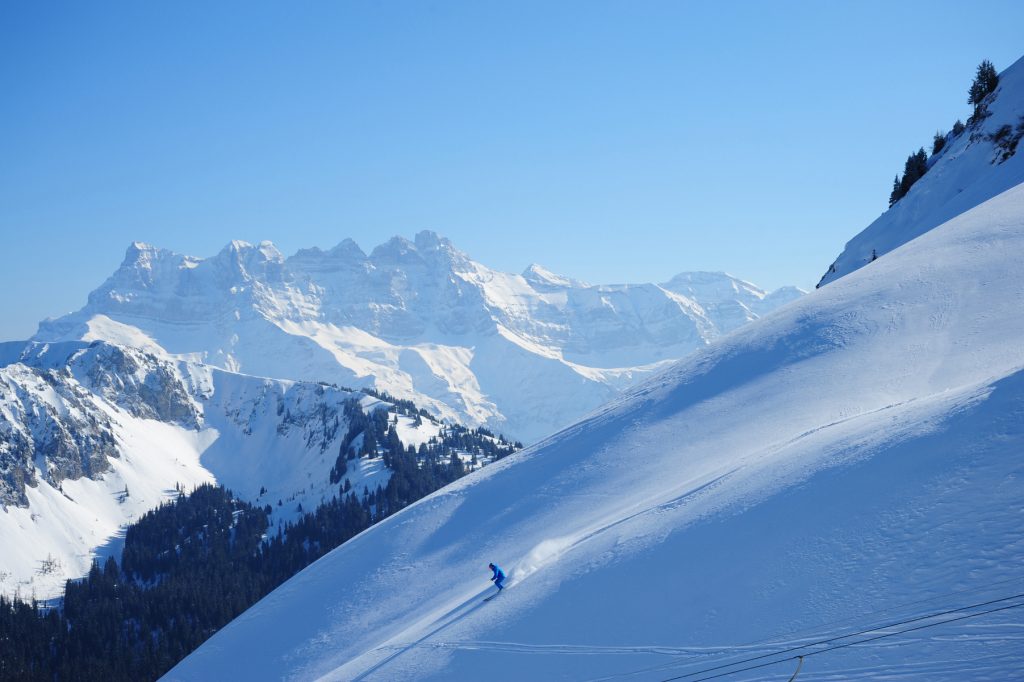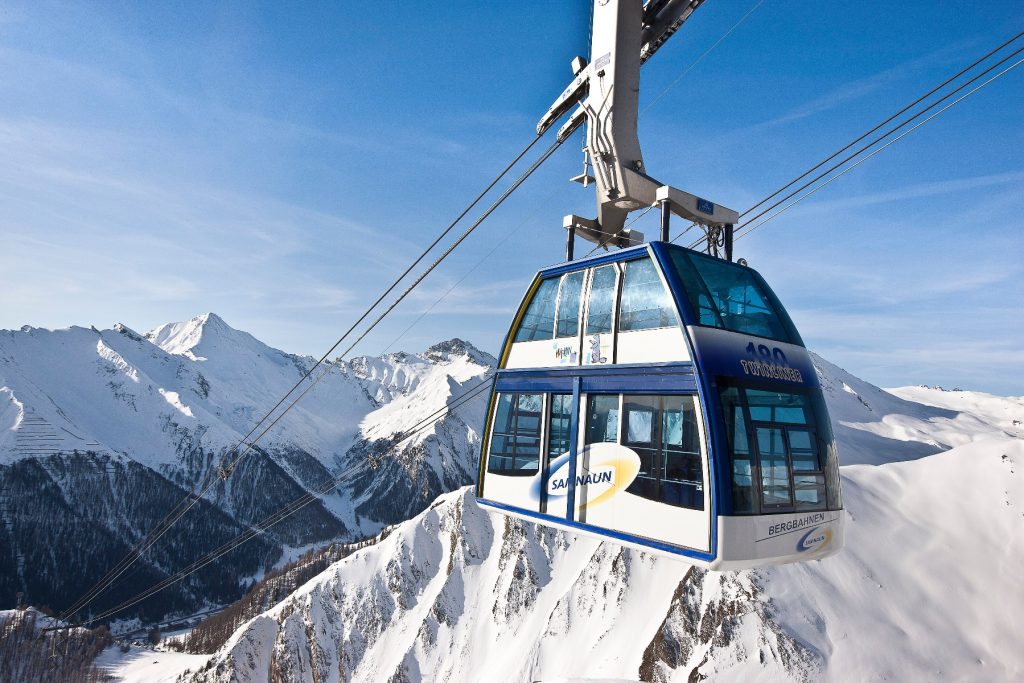Ski across borders from one country to the next for lunch or a spot of duty-free shopping, then be back in time for apres-ski drinks.
Crossing a border from one culture, cuisine and language to another is always a thrill, but on skis over majestic snow-covered mountains, it’s something special. Now you’re in one country and zip, you’re in another.
Janine Imesch of Zermatt Tourismus says, “Being able to ski on both sides of the border is a real plus for our visitors and they love to take advantage of it. It provides a great skiing area for both Swiss and Italians but it is much more the sense of adventure.”
Where to ski across borders
OnTheSnow looks at the best ski across borders . . .
Ski across borders: France/Switzerland

Les Portes du Soleil: This is one of the biggest snowy playgrounds in the world — stretches from Morzine in France to Champéry in Switzerland. The 650km ski area spans 12 linked ski resorts (eight French and four Swiss) and has something to suit every level. Avoriaz, Morzine and Chatel are the most popular stay options as they are bigger, busier resorts and also benefit from snowsure conditions and all are near the border.
On the French side are the two contrasting but closely linked resorts of Morzine and Avoriaz. Traditional Morzine, made up of Savoyard chalets, is tucked into a fold in the mountains while Avoriaz, with its avant-garde, neo traditional blocks of flats, perches on a cliff at 1,800m.
Chatel, a traditional village at its core, gets more than its fair share of snow due to its proximity to Lake Geneva – water evaporates and falls on the nearest mountain as snow (when the wind is favourable).
On the Swiss side, you’ll find pretty small villages with wooden chalets and red and green shutters, fondues, rösti and the excellent local wines. But the skiing is not so ‘cutesy’ as here lies the famous Swiss Wall – a rite of passage for ballsy young skiers. Starting at the top of the Pas de la Chavanette (2,151m) on the border it plunges 331m over a kilometre. Early risers will often find powder conditions, making it not nearly as terrifying, but leave it too late in the day and the Wall turns into a seriously steep icy mogul field. It is classified ‘orange’ which is beyond black.
Lunch on the border
Refuge l’Abricotine, 74110 Les Brochaux. A mountain refuge with access by ski lifts from both France and Switzerland. Great views of the Dent du Midi. Traditional Savoyard dishes including of course fondue Savoyard. Moonlight sledging if you stay the night.
Ski across borders: Switzerland/Austria

Silvretta Ski Arena: On the other side of Switzerland, duty-free Samnaun (1,840m) is part of one of the biggest ski areas in Austria: the 238km Silvretta Ski Arena. Samnaun, ideal for intermediates, is linked to Ischgl (1,377m) which has plenty of runs for confident intermediates, a superb modern lift system and an après-ski scene to rival that of St. Anton.
Both resorts are well integrated and the tourist offices tell us 90 percent of lift users ski across the border. A big plus is the fantastic scenery with 90 percent of the runs over 2,000m and wonderful views of the high mountains. The Silvretta ski pass also covers skiing in Galtur, Kappl and Sekappe.
From the Palinkopf (2,640m) in Austria, the 13km ‘80’ run, also known as the ‘duty-free run’, leads down to Samnaun, 860m below, and is great for elegant carving but not so good for boarders on the flatter sections. The Zeblas waterfalls can be bypassed by the less experienced.
Samnaun is the only duty-free area in Switzerland. The allowance is the usual personal 200 cigarettes and a litre of spirits per person. There is customs control on the Austrian side that extends well inside the resort so be careful.
To rejoin the main ski area in Ischgl you take the first double-decker gondola in the world to the Trida Sattel. From there you can also join the popular, and not too difficult, Alp Trida area. The runs back to Ischgl are all red and can be tricky when icy.
Swiss and Austria customs agents main a presence at busy border crossings and they sometimes stop skiers and riders for customs checks as Switzerland is not a member of the EU Customs Union.
Lunch on the border
Paznauner Taya, A-6561 Ischgl. Ski down from the Palinkopf into Austria and you’ll find the Paznauner Taya by the bottom station of the Hollspitzbahn. Enjoy long lunches in this very popular, lively setting.
Ski across borders: Switzerland/Italy

Matterhorn Ski Paradise: Zermatt (1,608m) in the shadow of the Matterhorn, is surely the grandest of the cross-border ski resorts. It is linked to Breuil Cervinia (2,009m) across the Italian border.
Both resorts are snowsure and ideal for intermediates, although Zermatt more for the adventurous intermediate. Consider which side you wish to base yourself as the links between the two resorts can be closed because of high winds, sometimes for a few days especially in early season. By the way, do you know what the French call the Matterhorn? Mont Cervin.
Generally once the lifts across the border are open they stay open for the rest of the day so you can get back. The lift pass is expensive but unless you are a complete beginner it is worth getting the ‘International Zermatt-Cervinia’ pass (360km), to avoid having to plan your trips across the border in advance.
Europe’s highest cable car takes you to the top of the Klein Matterhorn – now called the Matterhorn Glacier Paradise – where you have a 360-degree view of 38 peaks over 4,000 metres on both sides of the border. You can ski down in either country to the bottom: the run down to Cervinia is 16km (good for borders as few flat sections) and the run down to Zermatt is a muscle-burning 22km.
You can ski 365 days a year in Zermatt and from November to May in Cervinia.
Lunch on the border
Le Rifugio del Cervino, Loc. Plateau Rosa, Testa Grigia, 11021 Breuil Cervina. At the top of the Grigia lift, this historic guides’ hut is on the border on-route to the Matterhorn. Your favourite local Italian restaurant but with an awesome setting on the Testa Grigia ridge at 3,480m.
Don’t lose track of time however – if you miss the last lift, the circuitous four-hour taxi ride back is a second mortgage job and not recommended. It is an unbelievable 232km to get back to where you started from!
» Check out lodging options in Zermatt and in Cervinia-Breuil.
Ski between France and Italy

The Milky Way: With 410km of pistes between 1860m and 2800m, the Milky Way is one of the biggest winter sports areas in the world. It links Montgenèvre, one of France’s oldest resorts, to six Italian villages: Clavière, Cesana, Torinese, Sestrière, Pragelato, San Sicario and Sauze d’Oulx.
The lift infrastructure has greatly benefited from the ski and board events of the 2006 Winter Olympics and there are no less than 1,000 snow cannons. The highest point is Monta Motta 2800m in the Sestrière ski area. There you can try the men’s Olympic downhill or the super-G run if you are up to it. Sauze d’Oulx is very popular with Brits, particularly intermediates, and is famous for its lively après-ski. Heliskiing is legal on the Italian side only.
Montgenèvre, with 65km of ski runs, was the site of the first international ski race in 1907. It has since lost some of its pre-war glamour when it was a favourite with the glitterati of the day. It has however retained its heavy snowfalls and is also the easiest of the Franco-Italian alpine passes – you may well be skiing in the steps of Hannibal’s elephants. The old town is not without its charms and has been greatly improved by a tunnel taking the through traffic out of the main street.
Lunch on the border
La Bergerie, Télécabine du Chalvet, 05100 Montgenèvre. On the Italian border and in fact practically the only one. Enjoy tartiflette and Tartine de la Clarée on the huge sunny terrace with great views.
Espace San Bernardo: Two traditional villages lie on either side of the historic Petit Saint Bernard pass: La Rosière (1,850m) in France and La Thuile (1,441m) in Italy.
The family-friendly resort of La Rosière is modern but built sufficiently recently to have escaped the concrete plague that disfigured so many of the earlier post-war French resorts. Instead there is plenty of harmonious neo-traditional stone, wood and slate.
It is also the only south-facing resort in the Tarentaise and gets plenty of sun. Snowfall here is above average and kite skiing is popular on the plateau area beyond the pass. La Thuile is a large family resort with cheap Italian dining and popular with heli-boarding.
The two resorts are linked by the Belvédère lift on the Italian side and the Chardonnet and Bellecombe from the French side making a total of 150km of pistes and 38 lifts. The highest point for skiers is the Belvédère 2,600m.
The Espace San Bernardo website has recommended times of when to head home depending on which side you’re on: 3pm from Lathuile to France and 2:45pm from France if you ski right down to Les Ecudets at 1,176m well below La Rosière itself.
Lunch on the border
Le Plan du Repos, 73700 La Rosière – Montvalezan. By the top of the Les Eucherts ski lift on the French side makes up for it with magnificent views of the Vallée de la Tarentaise. Italians can ski down down from the Roc Noir.
Ski between Italy and Slovenia
Kanin-Bovec-Sella Nevea (1,100-2,300m) is the most recent ski resorts close to borders and is located between Slovenia and Italy. Before Slovenian independence from Yugoslavia and accession to the European Union the project was physically possible but politically unthinkable.
But by 2010 the link across the Julian Alps was opened and a cableway and piste now link the two resorts. The Doppelmayr Funifor 100P ropeway with two gondolas, each for 100 people, transports skiers from 1,845m to 2,133m in four minutes and 34 seconds.
The lift has a capacity for 1,300 people per hour. The new piste linking the resorts is suitable for all levels, from beginners upwards.
Kanin is the only ski centre in Slovenia with slopes over 2,000m. Bovec’s 15km of slopes and Sella Nevea’s 12km combine to form 27km of lift-linked pistes. Thanks to the climate, the resort has reliable late snow and is open well into May. On clear days you can see the Adriatic Sea and even ships way to the south off the Italian port of Trieste.
Lunch on the border
Prestreljenik Restaurant. Very competent, modern self-service with a brilliant view at 2,300m across the Julian Alps just below the peak of Mount Prestreljenik on the Slovenian side.
» Check out lodging options in Sella Nevea and in Kanin-Bovec.
There are other ski resorts close to borders, but they were some of our favourites.




